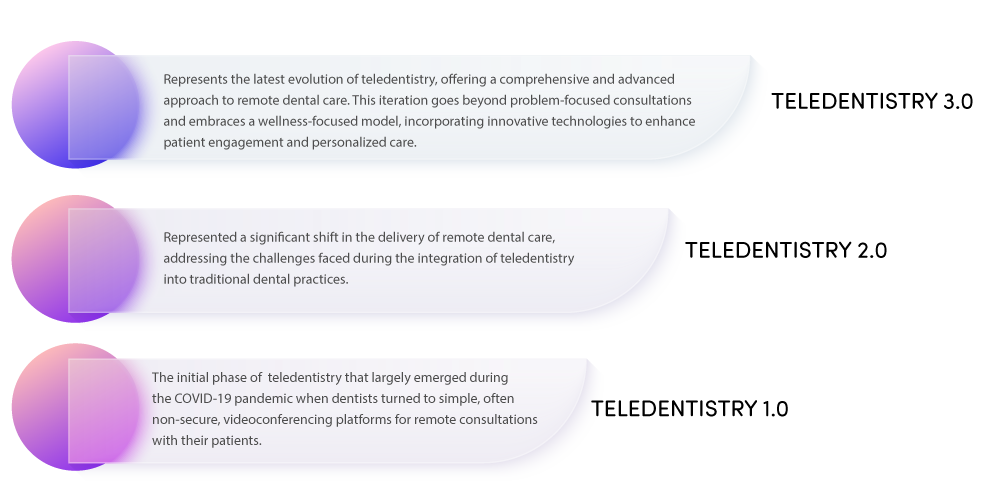Teledentistry has come a long way since its inception, and with the arrival of Teledentistry 3.0, there is even more innovation and progress in this field. In this blog post, we will define Teledentistry 3.0 and explore the unique features that set it apart from earlier versions of teledentistry.
Teledentistry 1.0
Teledentistry 1.0 refers to the initial phase of teledentistry that largely emerged during the COVID-19 pandemic when dental offices were forced to shut down and dentists turned to simple, often non-secure, videoconferencing platforms for remote consultations with their patients. This ad-hoc approach was characterized by a lack of standardized teledentistry software and limited experience among dentists in utilizing virtual platforms. As a result, the implementation of teledentistry 1.0 was marked by challenges and complexities, leading many dentists to discontinue its use once dental practices resumed normal operations.
Teledentistry 2.0
Teledentistry 2.0 represented a significant shift in the delivery of remote dental care, addressing the challenges faced during the integration of teledentistry into traditional dental practices. This iteration saw the emergence of specialized teledentistry network organizations that provide virtual networks of licensed dentists, dedicated to delivering remote consultations and services. These organizations have developed the necessary infrastructure and technology platforms to support seamless teledentistry experiences for both dentists and patients.
Teledentistry 2.0 went beyond the limitations of individual dentists attempting to navigate the complexities of remote care on their own. By leveraging virtual networks, patients gained access to a wider pool of licensed dentists, experienced in providing remote consultations. These organizations facilitated secure communication channels, secure data storage, and standardized protocols for remote assessments, diagnoses, and treatment planning.
Teledentistry 2.0 brought together the expertise of licensed dentists, the technological infrastructure, and the commitment to providing high-quality remote dental care. This innovative model fostered increased accessibility to oral health assessments, reduced geographical barriers, and improved patient experiences. Teledentistry 2.0 played a crucial role in expanding access to care and meeting the evolving needs of patients in today's digital age.
Teledentistry 3.0
Teledentistry 3.0 represents the latest evolution of teledentistry, offering a comprehensive and advanced approach to remote dental care. This iteration goes beyond problem-focused consultations and embraces a wellness-focused model, incorporating innovative technologies to enhance patient engagement and personalized care. Teledentistry 3.0 leverages cutting-edge tools such as artificial intelligence (AI) which when combined with virtual consultations can lead to improved assessments, treatment planning, and monitoring of oral health. It provides patients with a wide range of virtual dental services, including preventive care, and enables personalized treatment plans based on AI analysis and virtual advice from licensed dentists. Teledentistry 3.0 aims to revolutionize dental care by increasing convenience, accessibility, and the overall patient experience.
An important feature of Teledentistry 3.0 is the incorporation of advanced technologies such as AI. These technologies allow for more accurate diagnoses, personalized treatment plans, and improved patient outcomes. AI can analyze patient data, including images and diagnostic information, to assist both patients and dentists in making informed decisions about patient care.
In conclusion, Teledentistry 3.0 is a significant advancement in the field of teledentistry, offering a range of benefits to patients, dentists, and healthcare systems. It expands beyond problem-focused services. It offers wellness-focused services and utilizes advanced technologies such as AI. As the field of teledentistry continues to evolve, we look forward to seeing how Teledentistry 3.0 will further transform and improve dental care for patients everywhere.

